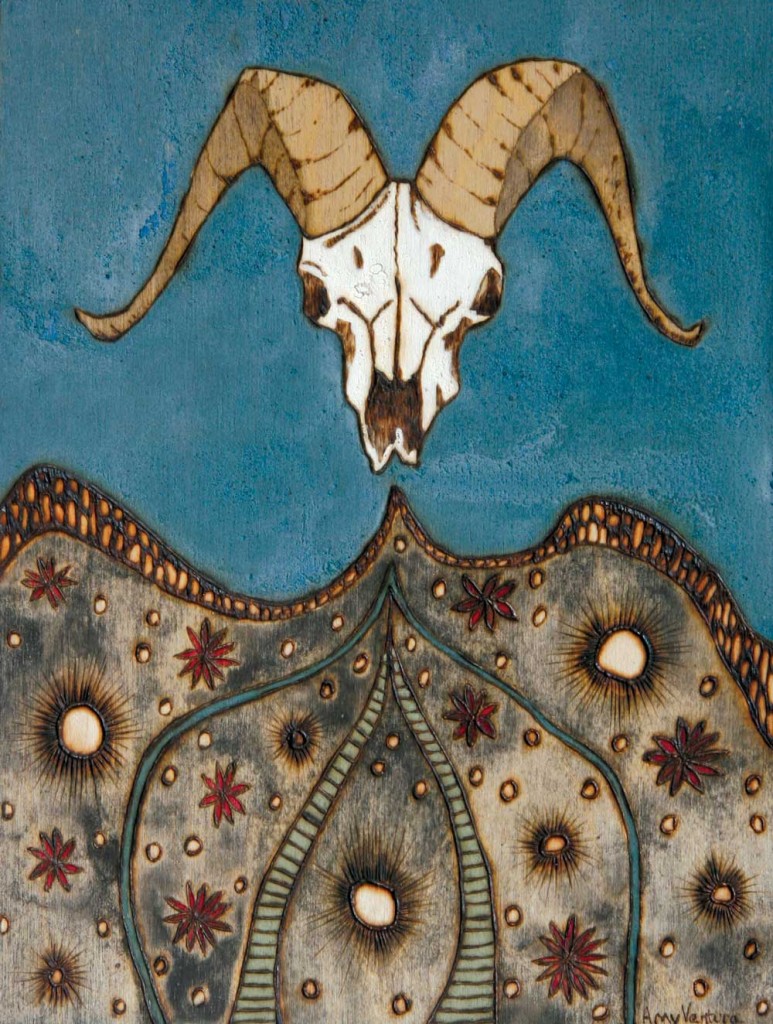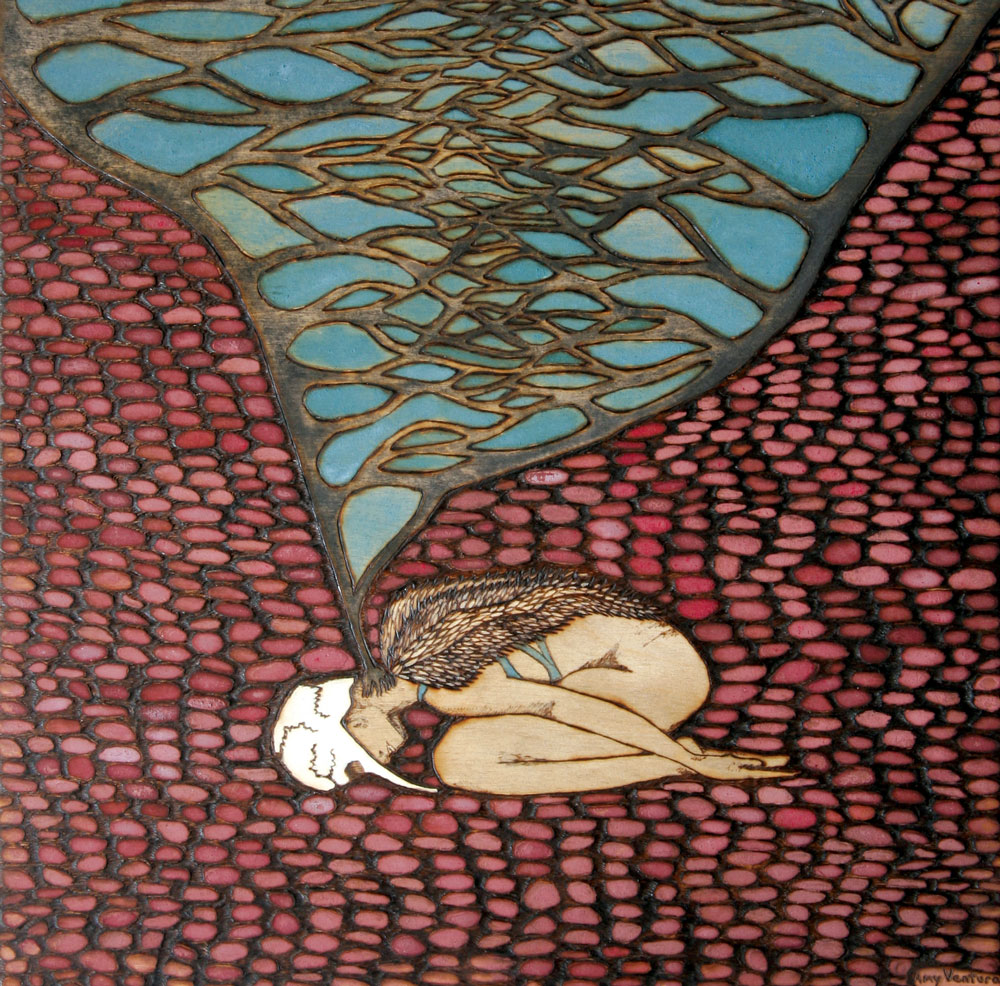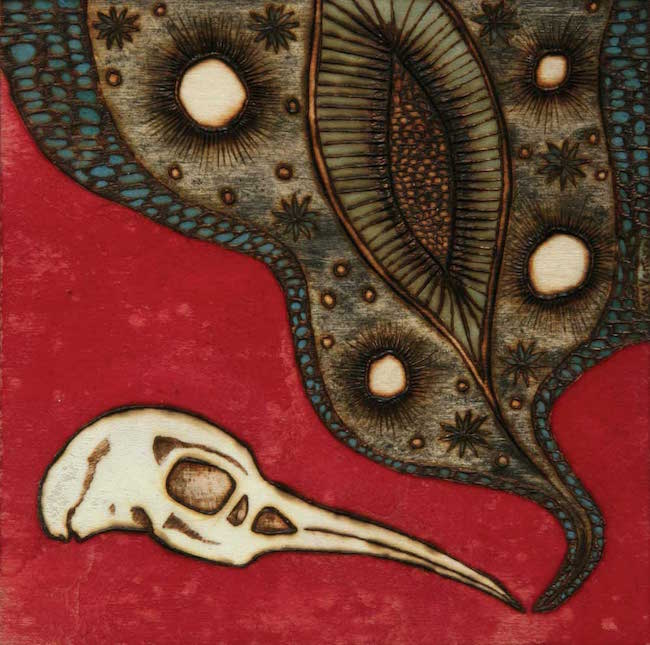From Cory: I’m so thrilled to see this guest post from Amy Ventura. Amy is a graduate of the Content Marketing for Artists (now called How to Sell Your Art Online) course, as well as a recent participant in our group coaching for artists program. Amy’s feedback on that program:
Loved that you had us create the 3-6 month plan (12 for me). That is EXACTLY what I wanted to get out of this experience — a “formula” of sorts for how to proceed, personalized for me. I was feeling completely overwhelmed with all the stuff I “should” be doing each day/week/month for my art business and the advanced coaching really helped me pull those scattered thoughts together into a cogent plan.
Now, on to Amy’s guest post!
I recently held my first-ever solo show, and it was a wonderful, challenging, exhilarating experience. Nothing I’d done or even imagined had prepared me for the thrill of encountering a gallery filled entirely with my work. Seeing my pieces on public display in a bright, well-lit room—and outside the confines of my studio—the work felt elevated. Yes, I admit, it felt good. Really good.
The year leading up to that solo show was a tremendous learning experience in terms of shaping my voice, organizing my work structure, and refining my creative process. What truly surprised me, however, was finding that the learning didn’t end once the show was hung. In fact, some of the most valuable lessons I learned through the entire process came after the opening. And it’s these I’m sharing with you below.
1) It ain’t over ‘til it’s over.
After all the hard work and late nights leading up to my show, I anticipated relaxing with some serious down time (and my Netflix queue) after the opening reception. I quickly realized, though, how foolish that would be. Having my artwork hanging for an entire month in a beautiful, well-respected gallery space? This was a golden opportunity not to be wasted. So I quickly got off the couch and back to work. I began by reaching out to potential collectors and others who showed interest in my work, making appointments and offering to personally tour them around the gallery. I accepted an invitation to speak about my work at a packed public event in the gallery space, which was intimidating but felt like an opportunity I couldn’t pass up. And later in the month, I wound up hosting an open house for friends who were unable to make it to my opening-night reception.
The results of these efforts paid off in sales. I sold two pieces on opening night, and the rest came afterward.

burned wood engraving finished with milk paint
2) It’s good to streeeeetch.
As a mentor of mine used to remind me, taking chances is an important part of personal growth. “Just because something feels uncomfortable doesn’t necessarily mean it’s wrong,” she said. “Often, we feel discomfort when we are stretching into new territory.” These last couple years, I’ve made that my personal mantra, as “uncomfortable” as it sometimes has been. I admit, I can sometimes be an introvert who’s most at home working alone all day in my studio. However, while my show was active and on view, I really pushed myself to step out of my comfort zone—to reach out and engage.
For instance, I was very nervous to speak at the public event I mentioned above. But I put together some thoughtful insights into the show, rehearsed my delivery and wound up creating an interesting story about my work and creative process that resonated with the audience. I also made myself available afterward to meet people and answer questions.
Later that month, the gallery director asked if I could fill in on an upcoming Saturday. I jumped at the chance to spend a whole day at the gallery; and instead of just sitting around waiting for potential customers to walk in off the street, I turned my shift into a special event. I advertised it to my mailing list and personal contacts as a Meet-the-Artist open house, complete with refreshments and, for parents, art activities to entertain their kids, which gave them a chance to view my artwork unobstructed. My efforts paid off—one set of parents did indeed purchase a piece that day, while their child was happily entertained with the art activities. Many others walked away excited by my work and engaged enough to sign up for my mailing list. Those names would not be on my list if I hadn’t created that event.
3) Treat your visitors like guests, and your clients like family.
I was very struck by Cassy Tully in the Abundant Artist podcast number six when she said: “I treat every person that has purchased an original work from me as family.”
As soon I heard that, I knew it was a philosophy I wanted to adopt. During my opening reception, for instance, I approached visitors warmly by welcoming them to the space, introducing myself, and asking if they had been to the gallery before. I patiently answered questions about the artwork and my process, and I was even game to pose for pictures with a family I had just met who wanted to document their evening out on the town. The next day, I individually emailed everyone I knew who had attended, thanking them for coming to the event and telling them how much their presence meant to me.
For the people who bought work, I was especially grateful and did the following things to make sure that the experience was nothing but positive:
- I provided shipping info directly to the gallery and followed up on both ends to ensure shipping would go smoothly
- When it made sense, I offered to deliver the artwork to local clients
- I stayed in contact with clients, inviting some to additional art shows based on their interests, or suggesting framing options for those who had inquired
I also tried to treat the director of the gallery with as much courtesy as possible. I made sure to thank him for his input, as well as the staff who worked the event. And since his input regarding (among other things) presentation and pricing proved invaluable, I got him a thank-you gift as well.
4) It really is all about who you know.
The gallery has a big contact list and brought a lot of people into my opening who were new to me and to my work. In the end, however, six of the seven sales I made were to my own contacts, and the seventh was to someone who was shared between the gallery and me. I was initially surprised by this, but in retrospect it makes sense from all I’ve learned about marketing. The people most interested in your artwork are the ones to whom you’ve told your story.

burned wood engraving finished with milk paint
5) Have a post-show plan.
I knew I would probably feel some postpartum pain after my opening, and I did. “What do I do next?” and “Is that it?” were questions that floated through my mind once the initial high wore off. Luckily, I had signed up for an advanced coaching course with Cory and had also laid out a general plan for 2015 goals and sales, so I didn’t have to flounder long. This gave me an immediate direction to face, and a path upon which to start.
Conclusion
All told, there may be areas I need to improve for my next show, but I’m proud of the gigantic push I made to stretch my boundaries and reach out to people during this one. I stepped well beyond my comfort zone and took advantage of the opportunities at hand, and it paid off.
My advice to those about to undertake a similar endeavor is to not underestimate the value of personal contact when you have work out in the world, and to remember these points:
- Your show is a huge opportunity that doesn’t end after opening night; maximize it by reaching out to potential collectors to personally show them the work, creating additional events in the space and taking advantage of any and all chances to meet people in person and talk about your art.
- Push yourself, even when it doesn’t feel natural. If you’re an introvert, act like an extrovert, even if it’s just for the duration of your show. People want to engage with the artist and learn the story behind the art.
- The show isn’t really about you; it is about the people who have taken the time out of their busy lives to come see it. Talk to them, thank them, and most of all, if they do happen to purchase something, follow through with them, making the experience as smooth and pleasant as possible.
And by all means, have fun!
Amy Ventura is a Chicago-based artist who creates burned wood engravings that combine her love of textures and patterns found in nature with a deep interest in the unconscious world of dreams, symbols and mythic folklore. To see more of her work, visit amyventura.com.


Amy, that was very helpful. I have an overfull plate with my wife and kids, house, full time job, & college, and lastly my part time art career. So, simple advice that is not complex in delivery or terminology is best for me. Thanks for sharing. I graduate college in May for mechanical engineering, which my passion has left for, and will be producing a lot more work. Presently, I put out a piece every couple months and participate in a show every few months with a lot of the same work. I’ll always remember some of the things you mentioned here, and good luck!
Timothy Cunningham
It’s great that you’re managing to make so much art and show it while you’re so busy with other areas of your life, Timothy. Best of luck!
Amy Ventura’s work seems original and unique. Simple figures reveals clear understanding of the subject being painted. Images shows expression of complicated and deeper pain often one has to experience during night with a companion or ,sometime, while missing companionship.
Thank you for your kind words about my work, Dharam.
Great article! I am planning my first solo show this spring and am book marking to reread closer to the time. Way to stretch yourself Amy! Love your work!!
Thank you, Nikol, and good luck with your solo show!
Amy, congratulations on your successful solo show, and thank you for sharing your strategies.
I am taking a huge leap of faith by participating in the New York Art Expo in April, and all of your tips are helpful.
Wishing you continued success.
Thank you, Debbie, and best of luck at the New York Art Expo!